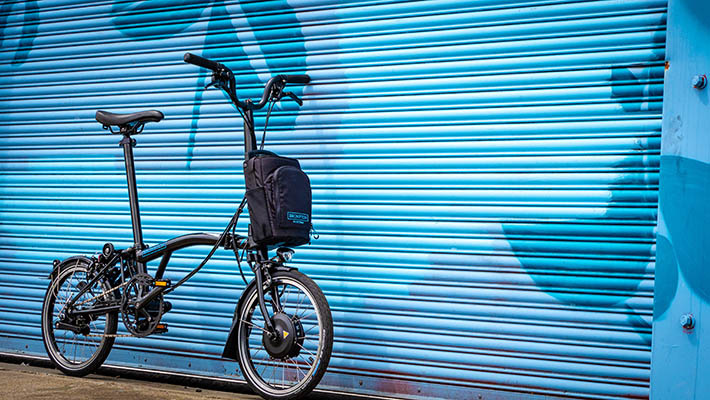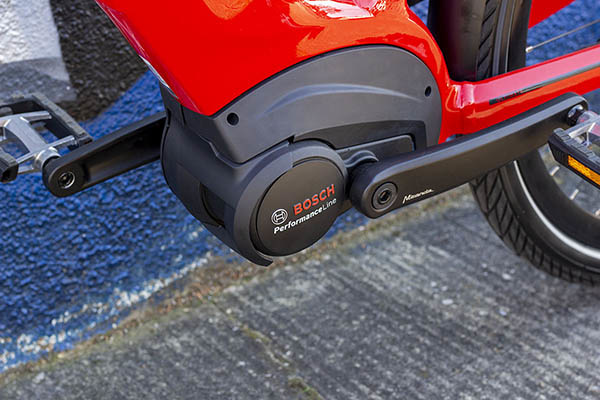Ebike Motors
Front Hub Motor vs Rear Hub Motor

The Brompton Electric. Sensors in the pedals tell the 250 W front hub motor exactly how much power is needed and when. The motor stops assisting at speeds higher than 15 mph.
Hub motors are located in the hub or center part of the wheel. A hub motor in the front wheel is called a front hub motor. Front hub motors are easier to install because you don’t have to work around cassettes, derailleurs, and chains. A hub motor in the rear wheel is called a rear hub motor. Rear hub motors are stealthier because of the gears. Front hub and rear hub motors work the same way—the motor spins the wheel, propelling the bike forward. An ebike rides differently depending on whether the motor is on the front or rear wheel. If you’re riding an ebike with a front hub motor, it can feel like you’re being pulled forward. On a rear hub motor ebike, it feels more like a push from behind. Front hub motors help with weight distribution as batteries are typically mounted in the middle or rear and weigh several pounds. You want the weight to be spread out. Though traction is another factor to consider.
Rear hub motors get better traction than front hub motors because there’s more weight on the back wheel (including most of your body weight) and it’s one of the reasons really powerful hub motors are installed on the rear. A downside of rear hub motors is that you don’t have the option to use an internally geared hub, which is more reliable and lower maintenance than a derailleur system.
Direct Drive Hub Motor vs Geared Hub Motor
A hub motor is either geared or direct drive. The right type of motor depends on what type of riding you want to do. Geared hub motors are better for riding in the city, where you have to stop a lot. For high speed uses, direct drive motors are the better choice. Direct drive motors, also called gearless hub motors, are bigger, heavier, and more powerful than geared hub motors. They are also simpler as there are really only two parts to them. Direct drive motors use a lot of energy or battery to get moving, but once they are moving they maintain and build speed efficiently. This is why direct drive motors are sometimes called speed motors. On the downside, direct drive motors are less efficient in stop-and-go traffic, and they’re not good at climbing hills.
Geared hub motors use planetary gear reduction systems to help with that. That’s why they’re called planetary motors, because they have planetary gears inside. Gears allow motors to work at higher, more efficient speeds. They convert high-speed, low-torque input from the motor to low-speed, high-torque output, and as a result, geared hub motors climb hills more efficiently and are more efficient off the line. It also means they consume a lot of energy to maintain high speeds. Unlike direct drive motors, geared hub motors have a freewheel, meaning they ride more like traditional bicycles.
Regenerative Braking
Regenerative braking is when a battery recharges during braking. Only direct drive motors are capable of this. When you squeeze the brakes on a bike with regenerative braking, regen for short, the motor becomes a generator and converts kinetic energy into electrical energy which is fed back into the battery pack. The energy gained from braking is minimal.
Mid Drive Motor

Bosch is the leader in mid drive motors. Their drive units are among the lightest and quietest on the market.
A mid drive motor propels a bike the same way pedaling does, via the bike’s drivetrain. It uses the bicycle’s existing gears for higher efficiency, which increases the number of miles you can travel on a single charge. This is also why mid drive motors are better at climbing hills. You’ll find a mid drive motor between the cranks (low to the ground, close to the bicycle’s center of gravity). With the weight of the motor at the center of the bike, you have even weight distribution, which is good for handling. The motor works in concert with your natural cadence and the weight is evenly distributed, so you get a natural feeling ride. Mid drive motors are designed to be easy to service and repair. Your mechanic can remove them with just a few bolts and without affecting other parts of the bike.
Mid Drive Motor vs Hub Motor

The BMC Alpenchallenge AMP City One is outfitted with Shimano's E6100 mid drive motor.
Mid drive motors are usually smaller and lighter than similarly powered hub motors. Since there’s no wiring between the frame and hub, changing a tire is easy, and you can run any wheelset you want. Unlike hub motors, which are in the front or rear wheel, mid drive motors are positioned in the center of the bike, which is good for handling. You get a natural feeling ride. Mid drive motors climb more efficiently than direct drive motors and low powered geared hub motors, meaning you can go further on a single charge. If you do run out of battery, pedaling will feel pretty normal. They have the advantage of using the bike’s gears for increased efficiency, but they do wear out chains and cogs more quickly (though belt drives circumvent this). Hub motors can weigh wheels down, affecting their ability to absorb bumps in the road and increasing the chance of flats. While not as practical as mid drive motors, hub motors are cheaper because they are produced in larger quantities and manufacturers don’t have to alter a frame at all.

Gocycle's proprietary front hub motor detects if and when the front tire loses grip.
Buying an Electric Bike vs Adding an Electric Bike Kit
An ebike is built one of two ways, from the ground up or by converting an existing bike. A purpose built ebike is one that is engineered to be an ebike. The frame is custom made to fit a certain ebike motor, the battery and other electrical components are integrated into the frame design, and certain components are chosen over others, like chains, rims, and brakes that are stronger thus better suited for a bike with more power. A converted ebike is a non-electric bike that has been electrified using an ebike conversion kit. One way to do this is to add a hub motor to the front or back wheel. This requires a wheel rebuild, possibly even a wheel upgrade as the rim and spokes need to be strong enough to handle a motorized hub. A converted ebike can be reverted to a regular bike by removing the conversion system, but a purpose built ebike can never be made into a regular bike.
Purpose Built Electric Bike Pros
- You have fewer decisions to make and less research to do.
- Your bike is...
- ready to ride, no tools required.
- built to handle the stress from a motor.
- equipped with one of the best ebike systems available.
- You get customer support from three reputable companies.
- It's easy to find a shop to service your bike.
Purpose Built Electric Bike Cons
- Quality bikes can cost several thousand dollars.
- You are locked into using that ebike system.
- Your bike can only be an ebike.
- Your upgrade options are limited.

Like all our ebikes, the Tern GSD S10 comes fully assembled and ready to personalize with optional kid and cargo accessories. Every Tern GSD comes with customer support from Tern, Bosch, and Clever Cycles.
Electric Bike Conversion Kit Pros
- Buying a conversion kit is usually cheaper than buying a complete bike.
- You can remove the system if you want to.
- You can switch systems if your needs change.
Electric Bike Conversion Kit Cons
- Your bike is not built for the stresses an ebike system puts on frames and components.
- Finding a quality kit with customer support requires hours of research.
- Installation is on you unless you find a shop to do it for you.
- Repair and maintenance is on you unless you find a shop to help you.
- The system isn't as well-integrated with the other components.

